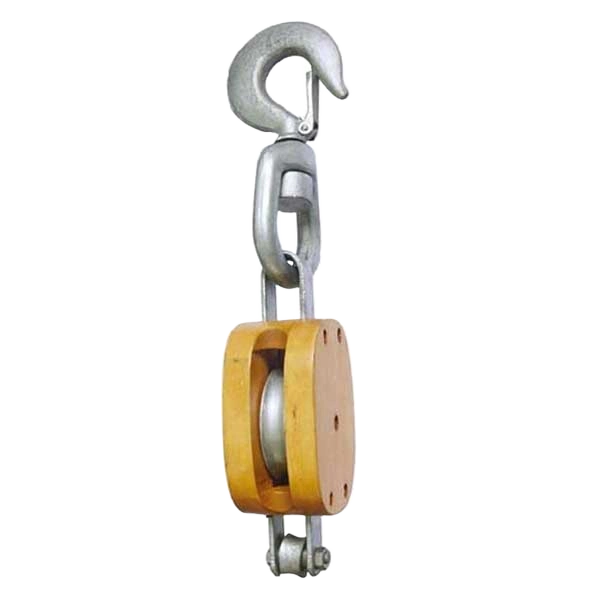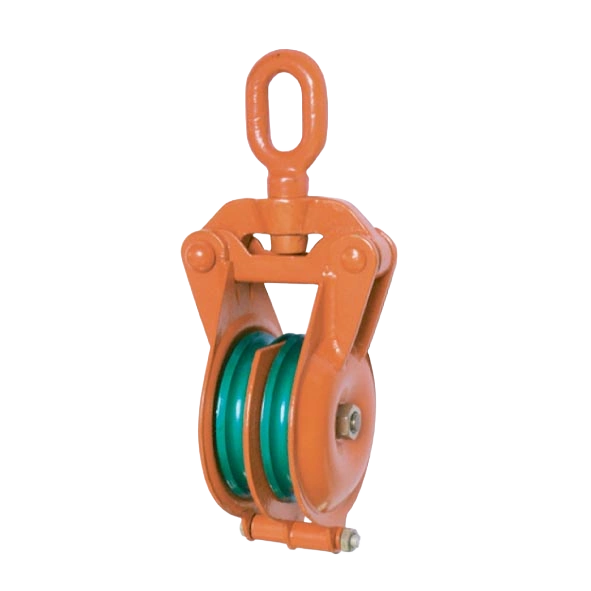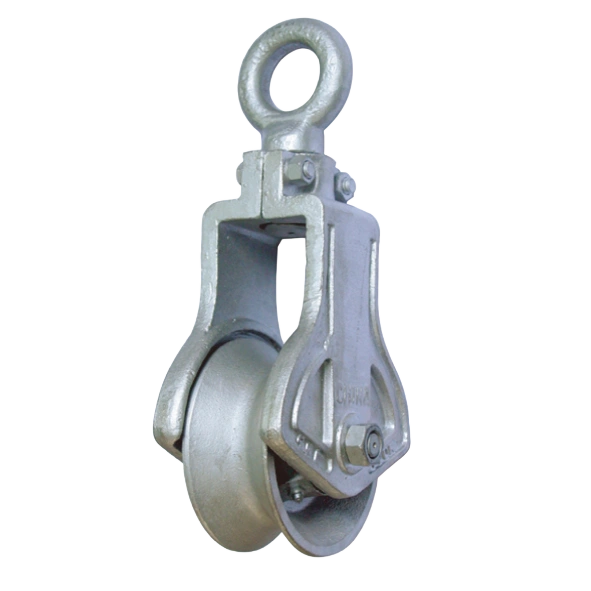PRODUCT FEATURES
- Steel Plate with Cast Sheave
- Electric Galvanized Finish
- Strong Steel Side Plate
- Color: Customizable to match specific requirements
- Swivel: Not included
Safety Notice:
Use only by competent, trained professionals.
Gear should be used strictly according to industry and OSHA standards.
Always inspect rigging and safety gear before use. Misuse may result in serious injury or death.
SPECIFICATIONS
| SIZE | S.W.L | DIAM OF ROPE |
| (IN) | (TON) | (MM) |
| 4 | 1.5 | 10 |
| 5 | 2.5 | 12 |
INSTRUCTIONS & CAUTIONS
Proper Use
Only use the steel rope pulley for its intended purpose — light lifting. Going beyond its recommended weight capacity could risk damaging the pulley or cause safety hazards. Always double-check the load limits before use to ensure you’re staying within the safe range.
Inspect Before Use
Always inspect the pulley before each use. Look for any wear, corrosion, or cracks, especially on the sheave and side plate. A quick check helps avoid unexpected issues during operation and ensures the pulley is still up to the task.
Follow Safety Guidelines
Stick to safety standards and OSHA regulations when using the pulley. This includes making sure your team is trained and that the pulley is used within its rated load capacity. Overloading the pulley could lead to serious accidents.
Care and Maintenance
Store the steel rope pulley in a dry, clean space after use to avoid rust and wear. Give it a regular clean-up to remove dirt or debris, and check for any necessary maintenance. Keeping it in top shape will help prolong its life and ensure smooth performance.
OUR ADVANTAGES
Direct from the Manufacturer
At Powerful Machinery, you get top-quality steel rope pulleys directly from the source. No middlemen, no markup—just reliable, cost-effective solutions for your lifting and rigging needs. Buying straight from the manufacturer ensures better prices, faster service, and more control over product quality.
Quality & Safety First
We focus on creating pulleys that meet the highest safety standards. Our steel rope pulleys undergo rigorous testing to ensure durability, strength, and performance. You can rely on our products for smooth operation and peace of mind, knowing they are built to last and certified for safe use in tough environments.
Custom-Engineered Solutions
Every rigging job is different. That’s why we offer custom-engineered solutions to meet your specific needs. Whether you need a unique size, material, or design, we work closely with you to create the perfect steel rope pulley for your project. No matter the challenge, we’ve got you covered.
Efficient Logistics & Transportation
We understand the importance of getting your gear on time. With our efficient logistics and transportation systems, we ensure fast, reliable delivery of steel rope pulleys—wherever and whenever you need them. You won’t have to worry about delays or unexpected shipping issues.
OUR REVIEWS



FAQ
How does a rope pulley work?
A rope pulley helps you lift heavy loads by changing the direction of force. When you pull the rope, the pulley redirects the force to lift or lower the load more easily. It reduces friction, making lifting tasks smoother and more efficient, whether you’re handling equipment or materials in your rigging setup.
What’s the difference between a steel rope pulley and a regular rope pulley?
Steel rope pulleys are made specifically for steel ropes or cables, which are stronger and more durable than regular ropes. These pulleys are built with robust materials, making them perfect for heavy-duty lifting. Regular pulleys, on the other hand, may not be strong enough to handle the strain of steel cables over time.
How do I choose the right size steel rope pulley for my project?
When choosing a steel rope pulley, make sure to consider the size of your rope and the weight of what you’re lifting. The sheave should be the right width for the rope to run smoothly without extra friction. It’s always a good idea to check the pulley’s specifications or ask for help if you’re not sure about the right fit.
Can steel rope pulleys be customized for specific needs?
Yes, many manufacturers offer custom steel rope pulleys tailored to your project’s specific requirements. Customizations can include size, load capacity, material type, and additional features like swivels or bearings. This ensures that the pulley fits your system perfectly, making your rigging or lifting tasks more efficient and safe.
How do I maintain a steel rope pulley?
-
Inspect for Wear and Damage
Regularly check the pulley for any signs of wear, corrosion, or damage to its components. This includes inspecting the sheave and side plate for cracks or rust. -
Clean the Pulley
Remove dirt, debris, and buildup from the pulley to keep it functioning smoothly. Cleaning helps prevent clogging and ensures efficient performance. -
Lubricate the Moving Parts
If necessary, lubricate the moving parts of the pulley to reduce friction and ensure the rope runs smoothly. -
Replace Damaged Pulleys
Always replace any pulleys that show signs of damage before use. Damaged pulleys can lead to system failures and pose safety risks.
What types of rigging systems use steel rope pulleys?
Steel rope pulleys are widely used in various rigging systems, including cranes, hoists, winches, and pulley blocks. They are essential in applications where heavy lifting, direction changes, or load distribution is needed, such as in construction, mining, and marine industries.
Can I use steel rope pulleys for multiple ropes at once?
Yes, steel rope pulleys are designed to work with one or more ropes, depending on your rigging needs. In systems with multiple ropes, pulleys help distribute the load more evenly, reducing the strain on each rope. However, it’s important to ensure that the pulleys are appropriately sized to accommodate the number of ropes you’re using.
Can I use a steel rope pulley in a high-temperature environment?
Yes, steel rope pulleys are often built to withstand a wide range of temperatures, including high heat. However, if you’re operating in extreme temperatures, it’s crucial to verify the pulley’s specifications for temperature tolerance. Some pulleys may need special coatings or materials to maintain their strength and performance in very high-temperature settings.




